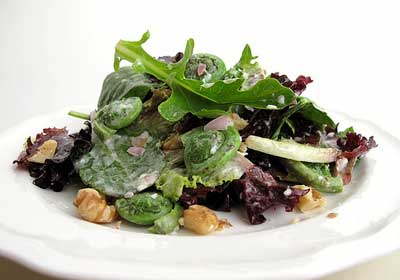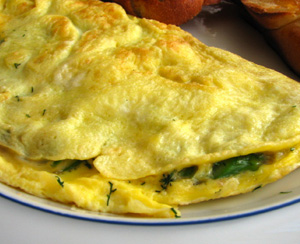 What do Jerusalem artichokes, horseradish and dandelion greens have in common? You'll never guess. Each has a name that is an English version of a foreign name. The Jerusalem artichoke is a variety of sunflower, and the name is derived from "girasole" which means sunflower in Italian. Horseradish is "meerrettich" in German and because "meer" sounds like "mare" the English called it horseradish. Dandelion comes from the French "dent de lion" or lion's tooth, in reference to the jagged leaves of this bitter yet tasty weed.
What do Jerusalem artichokes, horseradish and dandelion greens have in common? You'll never guess. Each has a name that is an English version of a foreign name. The Jerusalem artichoke is a variety of sunflower, and the name is derived from "girasole" which means sunflower in Italian. Horseradish is "meerrettich" in German and because "meer" sounds like "mare" the English called it horseradish. Dandelion comes from the French "dent de lion" or lion's tooth, in reference to the jagged leaves of this bitter yet tasty weed.
Like horseradish, dandelion has quite a bite to it. It can be eaten raw or cooked and like other leafy greens, it is a good source of vitamin A, calcium and iron. But frankly, I'd never cooked with it until this weekend. I found a Jamie Oliver recipe for a potato salad using chopped dandelion greens and I also heard raves about a potato salad with chopped fresh mint, so I decided to combine the two.
Spring
Spring
Ahhhsparagus
Before they disappear, run out and get those early season asparagus and fresh garlic bulbs and make this dish or the kitchen gods will be angry. This is a very versatile soup – it can be eaten, hot, lukewarm and cold. Unlike 99.99% of asparagus soups served in restaurants especially those in Paris, this soup has no cream. But it does have a secret fatty ingredient.
1.5 pounds asparagus – chopped
Reserve tips of 3 asparagus and mince very finely
4 cloves fresh spring garlic – garlic greens are also good (for a nice switcheroo substitute baby or spring ginger which is just coming into season – about a 1/2 inch piece chopped)
1/2 cup raw pumpkin seeds
3 cups chicken or vegetable stock
1/4 cup sake or dry white wine like a sauvignon blanc
Salt and ground black pepper to taste
Couple of pinches of coriander powder
1. Heat stock for 2 minutes; add all the ingredients except the minced asparagus tips and coriander. Heat under medium heat (covered) for 10 minutes.
2. Pour contents in a blender (if you have a Vitamix there is no need to strain it, but you may want to strain it to remove any woody asparagus pulp if you have a regular blender) for 3 minutes until completely smooth.
3. Pour contents back in pot under low heat for 10 minutes, add coriander powder and adjust salt.
4. Serve in bowls and garnish with minced asparagus.
Spring Greens and Fiddlehead Salad
 These curlicue-shaped fiddlehead greens are a specialty of the forest. They are actually fern fronds. Fiddleheads have such a short season since they're picked before the ferns have a chance to unfurl their fronds. They're definitely a specialty that you'll only see sold in farmers' markets and served in restaurants as a special dish of the evening. Rather expensive, fiddleheads are still worth buying, because a little does go a long way. Just a handful can add interest to salads or side dishes.
These curlicue-shaped fiddlehead greens are a specialty of the forest. They are actually fern fronds. Fiddleheads have such a short season since they're picked before the ferns have a chance to unfurl their fronds. They're definitely a specialty that you'll only see sold in farmers' markets and served in restaurants as a special dish of the evening. Rather expensive, fiddleheads are still worth buying, because a little does go a long way. Just a handful can add interest to salads or side dishes.
Fiddleheads are just plain fun to look at. Their flavor is like that of asparagus or green beans, very fresh and crisp if cooked just right. It is recommended that fiddleheads be cooked for about 10 to 15 minutes to kill any toxins, but I've never had a problem with them cooked for a shorter amount of time. Before cooking, I like to trim any brown area from the stem and soak the fiddleheads in a few changes of water. Then just boil or steam them until tender. Shock in ice water to preserve the bright green color. The fronds can then be used in salads or sauteed with onions or garlic for simple side dish.
Foxgloves and Delphiniums
 Elegant…purely elegant is the word that comes to mind when I think of foxgloves and delphiniums. Very similar in appearance and growth habit, these two garden goodies are excellent additions the spring tableau and fantastic in arrangements.
Elegant…purely elegant is the word that comes to mind when I think of foxgloves and delphiniums. Very similar in appearance and growth habit, these two garden goodies are excellent additions the spring tableau and fantastic in arrangements.
Digitalis purpurea is the Latin name for foxgloves. The genus Digitalis gathers its name from the ease of which one’s fingers, or digits, can be capped by the floral bells cascading down their stalks. In literary lore, a fox could slip its paws into the bells and use them as gloves - thus the common name. I bet Beatrix Potter had something to do with that. Pinks, creams, lavenders, lilacs, yellows, peaches, and speckled mixes of them all abound in the foxglove color range.
As for other uses besides gorgeous garden elements, the Digitalis genus is used in cardiology to create several types of heart medicine and even some neurological medicines. Quite amazing considering the whole plant, roots, leaves, seeds, and stems are toxic! The pharmaceutical positives are extracted from the leaves…somewhat akin to using snake venom for medicine or a flu vaccination. Don’t worry about the toxicity…just don’t eat them!
Spring Omelette
 The addition of fresh herbs breathes life into dishes. Herbs are vibrant, bright and introduce flavor that is so startlingly different from dried herbs that I can never understand recipes that imply they are interchangeable.
The addition of fresh herbs breathes life into dishes. Herbs are vibrant, bright and introduce flavor that is so startlingly different from dried herbs that I can never understand recipes that imply they are interchangeable.
In Italy I learned to make spaghetti with garlic, olive oil, chile flakes and parsley. It wasn't just the color contrast but the lively springiness of the parsley that made this simple dish so wonderful. Likewise sage leaves crisped up in butter or olive oil lend intensity and crunch, a handful of cilantro in a tossed green salad gives it a lemony zing and a sprinkle of chives on smoked salmon adds a delicate, almost sweet oniony flavor.
I have a little herb garden and I do mean little. A harvest of herbs from my window box is roughly equal to a generous garnish, so I have to keep raiding my mother's herb garden and buying herbs if I want to cook with them. Last week I got a chance to try Daregal fresh frozen herbs and found them to be surprisingly convenient and fresh tasting. I made a lovely omelette filled with asparagus and Jarlsberg cheese and a couple of pinches of Daregal frozen dill. This filling combination feels very Scandinavian to me though I have no idea if it really is...
More Articles ...
Welcome to the new One for the Table ...
Our Home Page will be different each time you arrive.
We're sure you'll find something to pique your interest...


